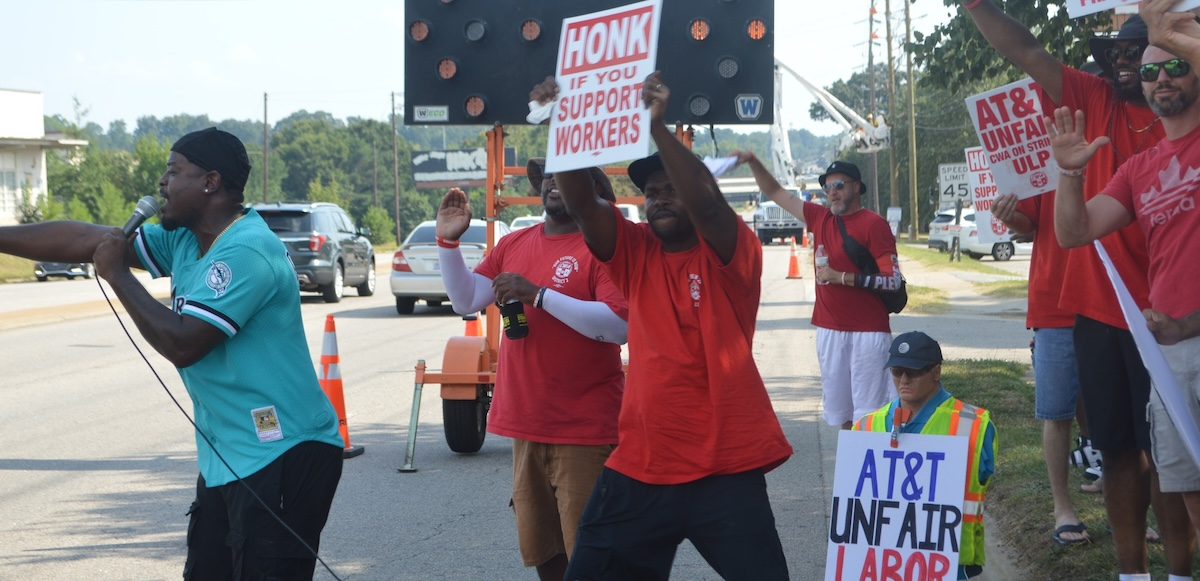AT&T Southeast Workers End Month-Long Strike

AT&T workers in North Carolina picketed in August. They returned to work after a month on strike. Photo: CWA Local 3611
Seventeen thousand AT&T workers in the Southeast returned to work September 16 following a month-long strike.
Members of the Communications Workers (CWA) in nine states from Kentucky to Florida walked out on an unfair labor practice strike August 16 over accusations the telecom giant was bargaining in bad faith.
The strike included technicians, call center workers, and others who build and maintain the AT&T network.
AT&T pulled in $24 billion in profits in 2023. CWA represents 65,000 AT&T workers in the U.S., scattered across more than a dozen collective bargaining agreements.
As we went to print, workers were to vote on whether to ratify the five-year agreement.
TWO-TIER
Two-tier was a major issue in negotiations. Twenty years ago, AT&T created a new class of installation and repair technicians, known as “wire technicians” in the Southeast and “premises technicians” in other regions. The company has used the position to shift work away from its higher-paid “core” technicians. Wire and prem techs now make up one-third of AT&T technicians across the country and are paid 35 percent less on average than core technicians.
CWA was pushing to significantly boost wire techs up the wage scale. In the end, the union only won an immediate 3 percent bump. The agreement also consolidates the three wage zones for wire techs into one.
The proposed contract includes 19.3 percent general wage increases over five years for all AT&T Southeast workers.
RAISING KIDS VIA FACETIME
Even before negotiations began, many AT&T CWA members were frustrated with the company, citing forced overtime, random performance metrics, and management disrespect.
“AT&T will send us an email saying ‘Your Family Matters,’ and on the same day our supervisor will tell us we can't go home to our families at the end of our shifts; instead, we have to keep picking up jobs until there are none left,” the union wrote in an August bargaining report.
Work-life balance is a major sticking point for wire techs in particular, whose schedules don’t provide consecutive days off and give them only one weekend free per month—not to mention long, unpredictable days.

SUPPORT LABOR NOTES
BECOME A MONTHLY DONOR
Give $10 a month or more and get our "Fight the Boss, Build the Union" T-shirt.
“They come in at 8 o’clock in the morning, they don’t know if they’re going to get home until 8 o’clock at night or 11 o’clock at night,” CWA District 3 President Richard Honeycutt told The Valley Labor Report. “There’s no work-life balance for them at all. They have to raise their kids, enjoy their T-ball game or dance through Facetime.”
CWA says poor conditions for wire techs lead to high turnover and short staffing, which hurts customers, too.
“This job demands a lot,” said Clarence Adams, a wire tech with Local 3611 outside Raleigh, North Carolina. “Trying to hold on to good quality people is very hard—[people are] not being paid enough, and you don’t have the work-life balance. Guys are coming home sometimes three hours after their shift.” Adams moved to North Carolina from Brooklyn, where he was part of the successful, years-long campaign to organize a union at Cablevision, now Altice.
A CWA survey of wire techs at AT&T Southeast found that 65 percent had applied for a job outside the company in the past year.
The new contract would cut the amount of weekly forced overtime the company can impose on wire techs from 14 hours to 12 and adds double-time pay after 54 hours. It also requires at least two hours’ notice before assigning overtime.
Health insurance was also a big issue. The tentative contract lowers monthly premiums for current workers through 2027, although deductibles and the cost of adding spouses will increase, and premiums will jump in 2028 and 2029. New hires will pay higher health insurance premiums.
LONGEST EVER
This year’s walkout was the longest strike ever by Southeast AT&T workers, eclipsing the 22-day strike in 1983 by 675,000 AT&T workers nationally.
CWA members nationally leafleted outside dozens of AT&T Mobility stores to inform the public about the strike.
Meanwhile, in California and Nevada, CWA members voted down a tentative agreement covering 8,500 AT&T workers in early September, with 58 percent voting no.
The bargaining committee reached a new agreement, yet to be ratified, on September 15 that it said includes improvements on overtime and scheduling. The four-year agreement means the union will be bargaining with the company again in 2028, while AT&T Southeast workers won’t return to the table until 2029.
Correction: This story has been updated to reflect the number of AT&T workers CWA currently represents. It is 65,000, not 150,000.





